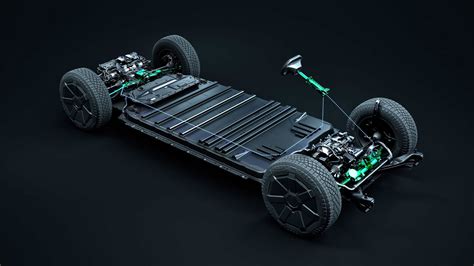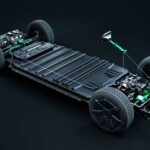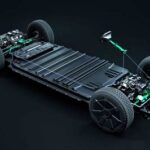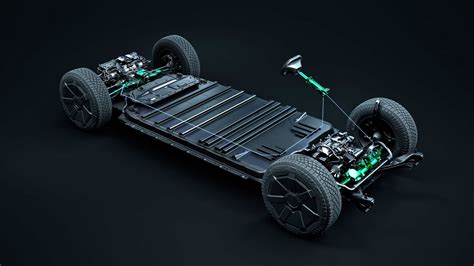
A Chinese electric vehicle startup, ZiDong, has unveiled its first vehicle, the ZiDong Zhiji L6, a direct competitor to Tesla’s Cybertruck, boasting advanced features like steer-by-wire technology, an adaptive chassis, and a unique onboard “intelligent fragrance system,” all at a starting price of around $41,000.
ZiDong, a new player in the EV market, is challenging Tesla with its Zhiji L6, which offers a blend of cutting-edge technology and competitive pricing aimed at attracting tech-savvy consumers. The vehicle’s features highlight the rapid advancements and increasing sophistication of the Chinese electric vehicle industry.
Zhiji L6: A Technological Showcase
The Zhiji L6 is positioned as a technologically advanced vehicle, designed to compete directly with established players like Tesla. Key features include:
-
Steer-By-Wire Technology: This advanced system eliminates the mechanical connection between the steering wheel and the wheels, offering a more responsive and customizable driving experience. Steer-by-wire systems are known for enhancing maneuverability and providing greater control, particularly in challenging driving conditions.
-
Adaptive Chassis: The adaptive chassis dynamically adjusts the vehicle’s suspension and damping based on road conditions and driving style, enhancing ride comfort and handling. This feature ensures a smooth and stable ride, regardless of the terrain.
-
Intelligent Fragrance System: This unique feature allows drivers to customize the vehicle’s interior ambiance with a selection of fragrances, adding a touch of luxury and personalization to the driving experience. While not a performance-related feature, it underscores ZiDong’s attention to detail and commitment to providing a premium experience.
Competitive Pricing and Market Positioning
Priced at approximately $41,000, the Zhiji L6 significantly undercuts the price of the Tesla Cybertruck and other premium electric vehicles. This competitive pricing strategy is aimed at attracting a broader range of consumers, particularly those who are price-sensitive but still desire advanced technology and features.
“The Zhiji L6 represents a compelling value proposition for consumers seeking a high-performance electric vehicle with advanced technology,” said a ZiDong spokesperson. “We believe that our combination of innovative features and competitive pricing will resonate with a wide range of customers.”
Advanced Technology and Features
The Zhiji L6 is packed with advanced technology and features designed to enhance the driving experience and provide a competitive edge. These include:
-
High-Performance Electric Powertrain: The vehicle is equipped with a high-performance electric powertrain that delivers impressive acceleration and range. While specific details on the powertrain’s performance are not yet available, ZiDong has indicated that the L6 will offer competitive performance figures.
-
Advanced Driver-Assistance Systems (ADAS): The Zhiji L6 features a comprehensive suite of ADAS technologies, including adaptive cruise control, lane keeping assist, automatic emergency braking, and blind-spot monitoring. These systems enhance safety and convenience, providing drivers with a more relaxed and confident driving experience.
-
Large Touchscreen Display: The vehicle’s interior is dominated by a large touchscreen display that integrates infotainment, navigation, and vehicle control functions. This user-friendly interface provides drivers and passengers with easy access to a wide range of features and information.
-
Over-The-Air (OTA) Updates: The Zhiji L6 supports OTA updates, allowing ZiDong to continuously improve the vehicle’s software and add new features over time. This ensures that the vehicle remains up-to-date and competitive throughout its lifespan.
Market Impact and Industry Trends
The launch of the Zhiji L6 highlights the rapid growth and increasing competitiveness of the Chinese electric vehicle industry. Chinese EV manufacturers are investing heavily in research and development, producing vehicles that rival those of established global brands in terms of technology, performance, and design.
“The Chinese EV market is one of the most dynamic and competitive in the world,” said an industry analyst. “Companies like ZiDong are pushing the boundaries of innovation and challenging the dominance of traditional automakers.”
The success of the Zhiji L6 could have a significant impact on the global electric vehicle market, potentially accelerating the adoption of EVs and intensifying competition among manufacturers. As Chinese EV brands continue to expand their presence in international markets, they are likely to exert increasing pressure on established players to innovate and reduce prices.
ZiDong: A Rising Star in the EV World
ZiDong is a relatively new player in the electric vehicle market, but the company has quickly gained attention for its innovative approach and ambitious goals. With the launch of the Zhiji L6, ZiDong is positioning itself as a serious contender in the global EV race. The company’s focus on advanced technology, competitive pricing, and a unique user experience could help it to attract a loyal customer base and establish a strong foothold in the market.
The automotive industry is experiencing unprecedented disruption, marked by rapid advancements in electric vehicle technology, autonomous driving capabilities, and connected car features. These trends are reshaping the competitive landscape, creating new opportunities for innovative startups like ZiDong to challenge established automakers.
Challenges and Opportunities
While ZiDong’s Zhiji L6 represents a significant achievement, the company faces several challenges in its quest to compete with established EV manufacturers. These challenges include:
-
Brand Recognition: ZiDong is a relatively unknown brand, and it will need to invest heavily in marketing and branding to build awareness and establish credibility among consumers.
-
Production Capacity: ZiDong will need to ramp up its production capacity to meet anticipated demand for the Zhiji L6. Scaling up production efficiently and effectively is a critical challenge for any new automaker.
-
Service and Support: ZiDong will need to establish a robust service and support network to provide customers with a positive ownership experience. This includes building service centers, training technicians, and providing roadside assistance.
Despite these challenges, ZiDong also has several opportunities to succeed. These include:
-
Strong Government Support: The Chinese government is strongly supporting the development of the electric vehicle industry, providing subsidies, tax incentives, and other forms of assistance to EV manufacturers.
-
Large Domestic Market: China is the world’s largest market for electric vehicles, providing ZiDong with a significant opportunity to build a strong customer base.
-
Focus on Innovation: ZiDong’s focus on advanced technology and innovative features could help it to differentiate itself from competitors and attract tech-savvy consumers.
Detailed Feature Analysis
To fully appreciate the Zhiji L6’s potential, a more in-depth look at its key features is warranted.
1. Steer-by-Wire System:
Traditional steering systems rely on a mechanical linkage between the steering wheel and the wheels. A steer-by-wire system replaces this mechanical linkage with electronic sensors and actuators. When the driver turns the steering wheel, sensors detect the movement and transmit electronic signals to actuators, which then turn the wheels.
-
Advantages:
- Enhanced Maneuverability: Steer-by-wire systems can offer more precise and responsive steering, making it easier to maneuver in tight spaces and navigate challenging road conditions.
- Customizable Steering Feel: The steering feel can be adjusted electronically to suit the driver’s preferences. This allows for a more personalized driving experience.
- Improved Safety: Steer-by-wire systems can be integrated with advanced driver-assistance systems (ADAS) to provide features such as lane keeping assist and automatic emergency steering.
- Packaging Benefits: Eliminating the mechanical linkage frees up space in the vehicle’s interior, allowing for more flexible design options.
-
Challenges:
- Reliability: Steer-by-wire systems rely on complex electronic components, which could potentially fail. Redundancy and fail-safe mechanisms are essential to ensure safety.
- Driver Feedback: Providing adequate feedback to the driver is crucial. Without a mechanical linkage, the system must simulate the feel of the road and the vehicle’s response to steering inputs.
2. Adaptive Chassis:
An adaptive chassis uses sensors and actuators to dynamically adjust the vehicle’s suspension and damping based on road conditions and driving style. This allows the vehicle to optimize its ride comfort and handling in real-time.
-
Components:
- Sensors: Sensors monitor road conditions, vehicle speed, steering angle, and other parameters.
- Electronic Control Unit (ECU): The ECU processes the sensor data and determines the optimal suspension and damping settings.
- Actuators: Actuators adjust the suspension and damping components based on the ECU’s commands.
-
Benefits:
- Improved Ride Comfort: The adaptive chassis can smooth out bumps and irregularities in the road, providing a more comfortable ride for passengers.
- Enhanced Handling: The adaptive chassis can adjust the suspension and damping settings to optimize the vehicle’s handling during cornering and other maneuvers.
- Increased Stability: The adaptive chassis can help to maintain vehicle stability in challenging driving conditions, such as on slippery surfaces or during sudden braking.
3. Intelligent Fragrance System:
While not a performance-related feature, the Zhiji L6’s intelligent fragrance system underscores ZiDong’s attention to detail and commitment to providing a premium user experience.
-
Functionality: The system allows drivers to select from a variety of fragrances to customize the vehicle’s interior ambiance. The fragrance can be diffused automatically based on pre-set preferences or manually controlled by the driver.
-
Benefits:
- Enhanced Sensory Experience: The fragrance system adds a new dimension to the driving experience, creating a more pleasant and personalized environment.
- Stress Reduction: Certain fragrances have been shown to reduce stress and improve mood, potentially making driving more relaxing and enjoyable.
- Brand Differentiation: The fragrance system helps ZiDong to differentiate its vehicles from competitors and create a unique brand identity.
4. Competitive Landscape and Market Dynamics
The Zhiji L6 enters a highly competitive electric vehicle market, dominated by established players like Tesla and BYD. To succeed, ZiDong will need to differentiate its vehicles and offer compelling value to customers.
-
Tesla: Tesla is the leading electric vehicle manufacturer in the world, known for its advanced technology, high performance, and strong brand recognition. The Cybertruck, while controversial in its design, has generated significant interest and pre-orders.
-
BYD: BYD is a Chinese electric vehicle manufacturer that has rapidly grown in recent years, becoming a major player in the global EV market. BYD offers a wide range of electric vehicles, from small city cars to large SUVs.
-
Other Competitors: Other notable competitors in the electric vehicle market include Volkswagen, General Motors, Ford, and Hyundai. These companies are investing heavily in electric vehicle technology and are launching new models to compete with Tesla and BYD.
5. Regulatory and Policy Environment
Government regulations and policies play a significant role in shaping the electric vehicle market. Subsidies, tax incentives, and emission standards can all influence consumer demand and manufacturer behavior.
-
China’s EV Policies: The Chinese government has implemented a range of policies to promote the adoption of electric vehicles, including subsidies for EV purchases, tax incentives for EV manufacturers, and strict emission standards for gasoline-powered vehicles.
-
Global EV Policies: Governments around the world are implementing policies to encourage the adoption of electric vehicles, driven by concerns about climate change and air pollution. These policies include subsidies, tax incentives, emission standards, and regulations requiring automakers to sell a certain percentage of electric vehicles.
FAQ: ZiDong Zhiji L6
1. What is the ZiDong Zhiji L6?
The ZiDong Zhiji L6 is an electric vehicle manufactured by the Chinese EV startup ZiDong. It is designed to compete with vehicles like the Tesla Cybertruck and boasts advanced features such as steer-by-wire technology, an adaptive chassis, and an intelligent fragrance system.
2. How much does the ZiDong Zhiji L6 cost?
The ZiDong Zhiji L6 has a starting price of approximately $41,000, making it a competitively priced option compared to other electric vehicles with similar features.
3. What are the key features of the ZiDong Zhiji L6?
Key features include:
- Steer-by-wire technology for enhanced maneuverability and customizable steering feel.
- An adaptive chassis that dynamically adjusts suspension and damping for improved ride comfort and handling.
- An intelligent fragrance system to personalize the vehicle’s interior ambiance.
- Advanced Driver-Assistance Systems (ADAS) for enhanced safety and convenience.
- A large touchscreen display for infotainment and vehicle control.
- Over-The-Air (OTA) updates to continuously improve the vehicle’s software and add new features.
4. What is steer-by-wire technology and how does it benefit drivers?
Steer-by-wire technology replaces the mechanical connection between the steering wheel and the wheels with electronic sensors and actuators. This offers several benefits, including:
- Enhanced maneuverability and more precise steering.
- Customizable steering feel to suit driver preferences.
- Improved safety through integration with ADAS features.
- More flexible interior design options.
5. How does the adaptive chassis work and what are its advantages?
The adaptive chassis uses sensors and actuators to dynamically adjust the vehicle’s suspension and damping based on road conditions and driving style. This results in:
- Improved ride comfort by smoothing out bumps and irregularities in the road.
- Enhanced handling during cornering and other maneuvers.
- Increased stability in challenging driving conditions.
The ZiDong Zhiji L6 presents a compelling case as a technologically advanced and competitively priced electric vehicle. Its success will depend on its ability to overcome challenges related to brand recognition, production capacity, and service support. The car is positioned to take the EV market to the next level with its unique features and advanced technology.
ZiDong’s aggressive strategy, combined with favorable government policies in China, could significantly disrupt the global EV market. The Zhiji L6 is more than just a car, it’s a symbol of the evolving automotive industry and the growing prominence of Chinese EV manufacturers on the world stage.









